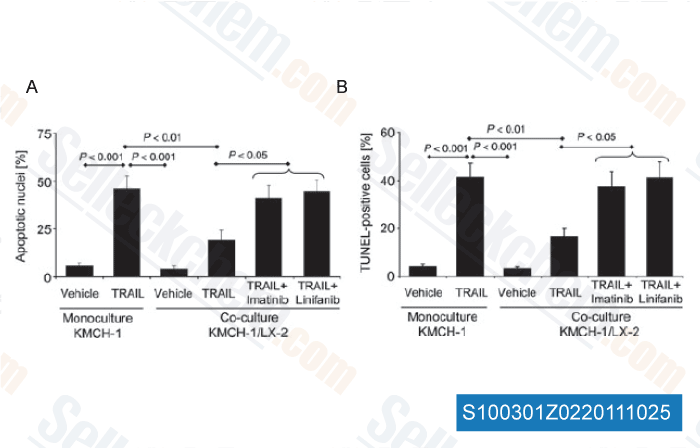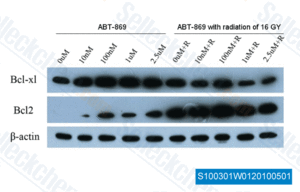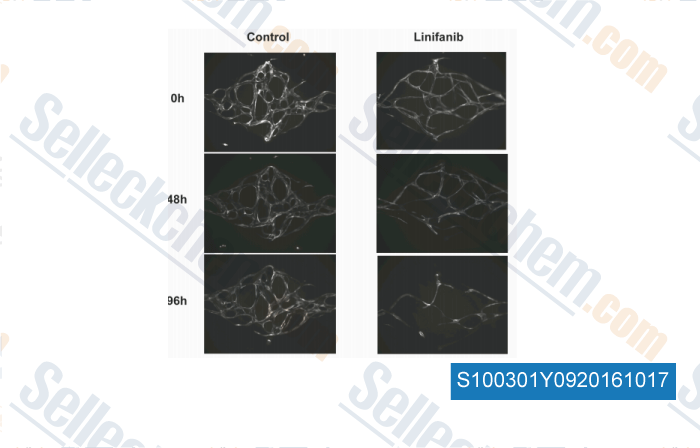|
Toll Free: (877) 796-6397 -- USA and Canada only -- |
Fax: +1-832-582-8590 Orders: +1-832-582-8158 |
Tech Support: +1-832-582-8158 Ext:3 Please provide your Order Number in the email. |
Technical Data
| Formula | C21H18FN5O |
|||
| Molecular Weight | 375.41 | CAS No. | 796967-16-3 | |
| Solubility (25°C)* | In vitro | DMSO | 75 mg/mL (199.78 mM) | |
| Water | Insoluble | |||
| Ethanol | Insoluble | |||
|
* <1 mg/ml means slightly soluble or insoluble. * Please note that Selleck tests the solubility of all compounds in-house, and the actual solubility may differ slightly from published values. This is normal and is due to slight batch-to-batch variations. * Room temperature shipping (Stability testing shows this product can be shipped without any cooling measures.) |
||||
Preparing Stock Solutions
Biological Activity
| Description | Linifanib (ABT-869, AL39324, RG3635) is a novel, potent ATP-competitive VEGFR/PDGFR inhibitor for KDR, CSF-1R, Flt-1/3 and PDGFRβ with IC50 of 4 nM, 3 nM, 3 nM/4 nM and 66 nM respectively, mostly effective in mutant kinase-dependent cancer cells (i.e. FLT3). Linifanib (ABT-869) induces autophagy and apoptosis. Phase 3. | |||||||||||
|---|---|---|---|---|---|---|---|---|---|---|---|---|
| Targets |
|
|||||||||||
| In vitro | Linifanib shows inhibitory to Kit, PDGFRβ and Flt4 with IC50 of 14 nM, 66 nM and 190 nM in kinases assay. Linifanib also inhibits ligand-induced KDR, PDGFRβ, Kit, and CSF-1R phosphorylation with IC50 of 2 nM, 2 nM, 31 nM and 10 nM at cellular level and this cellular potency could be affected by serum protein. Linifanib suppresses VEGF-stimulated HUAEC proliferation with IC50 of 0.2 nM. While Linifanib has weak activity against tumor cells which are not induced by VEGF or PDGF, except for MV4-11 leukemia cells (with constitutively active form of Flt3) with IC50 of 4 nM. Linifanib could cause a decrease in S and G2-M phases with a corresponding increase in the sub-G0-G1 apoptotic population in MV4-11 cells. [1] Linifanib binds to the ATP-binding site of CSF-1R with Ki of 3 nM. [2] Linifanib (10 nM) exhibits a reduced phosphorylation of Akt at Ser473 and decreased phosphorylation of GSK3βat Ser9 in Ba/F3 FLT3 ITD cell lines. [3] | |||||||||||
| In vivo | Linifanib (0.3 mg/kg) results in complete inhibition of KDR phosphorylation in lung tissue. Linifanib also inhibits the edema response with ED50 of 0.5 mg/kg. Linifanib (7.5 and 15 mg/kg, bid) significantly inhibits both bFGF- and VEGF-induced angiogenesis in the cornea. Linifanib inhibits tumor growth in flank xenograft models including HT1080, H526, MX-1 and DLD-1 with ED75 from 4.5-12 mg/kg. Linifanib also shows efficacy in A431 and MV4-11 xenografts at low dose levels. Linifanib (12.5 mg/kg bid) reveals a decrease of microvasculure density in MDA-231 xenograft. Linifanib shows a Cmax and AUC24 hours with 0.4 μg/mL and 2.7 μg•hour/mL in HT1080 fibrosarcoma model. [1] |
Protocol (from reference)
| Kinase Assay:[1] |
|
|---|---|
| Cell Assay:[1] |
|
| Animal Study:[1] |
|
References
Customer Product Validation

-
Data from [Liver Int, 2011, 32, 400-409]

-
, , Dr. Zhang of Tianjin Medical University

-
Data from [Data independently produced by , , Sci Rep, 2016, 6:31589.]
Selleck's Linifanib (ABT-869) has been cited by 34 publications
| Sensitizing cholangiocarcinoma to chemotherapy by inhibition of the drug-export pump MRP3 [ Biomed Pharmacother, 2024, 180:117533] | PubMed: 39405909 |
| Repositioning linifanib as a potent anti-necroptosis agent for sepsis [ Cell Death Discov, 2023, 9(1):57] | PubMed: 36765040 |
| Repositioning linifanib as a potent anti-necroptosis agent for sepsis [ Cell Death Discov, 2023, 9(1):57] | PubMed: 36765040 |
| Integrative analysis of drug response and clinical outcome in acute myeloid leukemia [ Cancer Cell, 2022, S1535-6108(22)00312-9] | PubMed: 35868306 |
| A community challenge for a pancancer drug mechanism of action inference from perturbational profile data [ Cell Rep Med, 2022, 3(1):100492] | PubMed: 35106508 |
| Establishment and Characterization of NCC-PMP1-C1: A Novel Patient-Derived Cell Line of Metastatic Pseudomyxoma Peritonei [ J Pers Med, 2022, 12(2)258] | PubMed: 35207746 |
| Establishment and characterization of NCC-UPS4-C1: a novel cell line of undifferentiated pleomorphic sarcoma from a patient with Li-Fraumeni syndrome [ Hum Cell, 2022, 10.1007/s13577-022-00671-y] | PubMed: 35118583 |
| In vivo screen identifies a SIK inhibitor that induces β cell proliferation through a transient UPR [ Nat Metab, 2021, 3(5):682-700] | PubMed: 34031592 |
| Expression of activated VEGFR2 by R1051Q mutation alters the energy metabolism of Sk-Mel-31 melanoma cells by increasing glutamine dependence [ Cancer Lett, 2021, 507:80-88] | PubMed: 33744390 |
| Establishment and characterization of the NCC-GCTB4-C1 cell line: a novel patient-derived cell line from giant cell tumor of bone [ Hum Cell, 2021, 10.1007/s13577-021-00639-4] | PubMed: 34731453 |
RETURN POLICY
Selleck Chemical’s Unconditional Return Policy ensures a smooth online shopping experience for our customers. If you are in any way unsatisfied with your purchase, you may return any item(s) within 7 days of receiving it. In the event of product quality issues, either protocol related or product related problems, you may return any item(s) within 365 days from the original purchase date. Please follow the instructions below when returning products.
SHIPPING AND STORAGE
Selleck products are transported at room temperature. If you receive the product at room temperature, please rest assured, the Selleck Quality Inspection Department has conducted experiments to verify that the normal temperature placement of one month will not affect the biological activity of powder products. After collecting, please store the product according to the requirements described in the datasheet. Most Selleck products are stable under the recommended conditions.
NOT FOR HUMAN, VETERINARY DIAGNOSTIC OR THERAPEUTIC USE.
